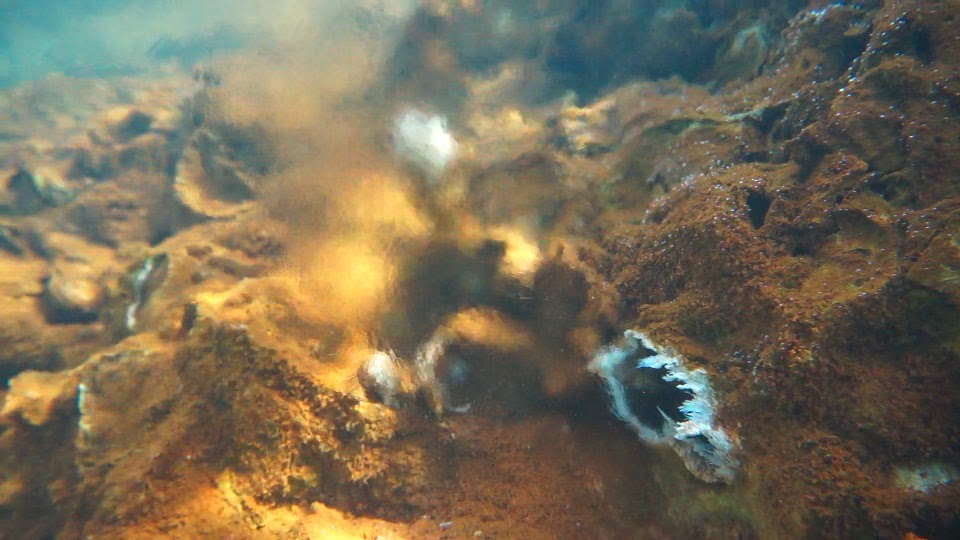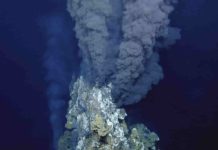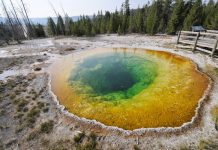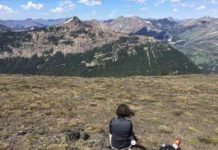
Roy Price first heard about the hydrothermal vents in New Caledonia’s Bay of Prony a decade ago. Being a scuba diver and a geologist, he was fascinated by the pictures of a 38-meter-high calcite “chimney” that had precipitated out of the highly-alkaline vent fluid.
His attraction to this South Pacific site intensified over the years, as it was later revealed that the geochemistry of the hydrothermal fluids discharging in the Bay of Prony resemble that of the mid-Atlantic’s “Lost City,” one of the most spectacular of all hydrothermal vent systems. The unique chemical and biological conditions at the Lost City has led some scientists to speculate that the origin of life may have occurred around similar sorts of vents in the Earth’s distant past.
“The site in New Caledonia is very similar to the Lost City in many ways,” Price said.
Like the Lost City, the water that bubbles out of the Prony vents has an extremely alkaline pH of around 11. Temperatures reach up to 40° C (104° F) in some places, and fluids are highly enriched in dissolved hydrogen (H2) and methane (CH4). Calcium dissolved in the fluids reacts with bicarbonate in seawater, which leads to the formation of tall, monolithic calcite chimneys that look like ruins from an ancient civilization.
Besides having many geochemical similarities, Prony and the Lost City also have similar microbiology, as demonstrated by recent work from the “HYDROPRONY” research group, an interdisciplinary research team affiliated with the Mediterranean Institute of Oceanography (MIO) and the French Institute of Research for Development (IRD).
One big difference, however, is that the Lost City is nearly a kilometer underwater, whereas the main Prony chimney, called “the Needle of Prony” or “l’Aiguille” in French, nearly breaches the water surface, making the site accessible to divers.
Price, who is now a researcher at the School of Marine and Atmospheric Sciences, State University of New York, Stony Brook, asked the HYDROPRONY group for permission to join them on a field expedition in April 2014. His motivation was to test whether the Prony vents can produce organic compounds abiotically, without any biological influence.
“The abiotic production of hydrocarbons and other simple organic compounds in places such as these may have led or at least contributed to abiogenesis—the [long-ago] switch from abiotic chemical reactions to biologically-mediated reactions probably similar to today’s microbial metabolisms,” Price said.
With funding from a NASA Early Career Collaboration award, Price flew to New Caledonia to test whether the chemical precursors of this ancient switch can be found in Prony Bay.
Early Earth analog
As soon as he arrived on New Caledonia, Price was struck by the red soil that covers the southern part of the main island. This soil comes from the erosion of ultramafic rock, which is a rare type of iron-rich, silica-poor rock, only found in a few places on earth today.
Ultramafic rocks give rise to the hydrothermal vents in both Prony Bay and the Lost City. When exposed to water, ultramafic rocks go through a chemical weathering process called serpentinization. Specifically, the iron in the rock oxidizes, producing hydrogen gas (H2), as well as heat. The hydrogen reacts with carbon dioxide in the water to produce one of the simplest organic molecules, methane (CH4).
“This is a key point—an organic compound produced without any biological interactions whatsoever,” Price explained. “Other slightly more complex organic molecules can also be produced abiotically.”
Ultramafic rocks are not very common on the Earth’s surface now, so it’s rare to find areas with ongoing serpentinization. But billions of years ago when life was getting its start, “ultramafic rocks may have been much more abundant,” Price said. The Earth was much hotter back then, allowing more iron-rich (ultramafic-producing) lava to flow up from the mantle to the crust.
One might imagine, then, that the first precursors to life took advantage of the conditions around these types of hydrothermal vents, co-opting the geochemical reactions to form their own “biological serpentinization” that extracted energy from the reduction of carbon dioxide with hydrogen, forming methane in the process.
Price’s experiments in New Caledonia could provide some ground truth for these origin-of-life speculations. The methane and hydrogen in the hydrothermal fluids from Prony will be analyzed in the lab to determine their carbon and hydrogen isotopic abundances. If the vent’s methane is enriched in carbon-13 and depleted in deuterium (heavy hydrogen), that could be evidence of abiotic production.
“If the methane is produced abiotically, then we will have in the Prony hydrothermal site an early Earth analog which may help us understand the complex sequence of events which led to the origin of life,” Price said.
Fielding an answer
In the days leading up to his first dive, Price spoke with several IRD researchers, including Bernard Pelletier and Claude Payri, the investigators who recently ‘rediscovered’ the hydrothermal cones in the Bay of Prony.
On April 16, Price met the diving leader, Eric Folcher of IRD, who drove him out to the boat launch on the bay. They were joined in the field by two members of the HYDROPRONY group—microbiologists Gaël Erauso of the Mediterranean Institute of Oceanography (University of Marseille) and Mylène Hugoni of the University Blaise Pascal. They are studying the genetic make-up of the microbes and viruses that inhabit the vent environments.
“The weather was particularly good this day, lacking the nearly constant wind the island experiences,” Price recounted. “This not only meant a very smooth ride out to the Needle, but also hinted that there would be very good visibility during the dive.”
When the team’s boat pulled into position, Price caught his first glimpse of the Needle, with its mineral-crusted dome clearly visible about 3 meters below the surface.
Price prepared his sampling equipment, which included several gas-tight syringes to syphon fluids discharging from the vents. When he and Folcher dived in the water, they were immediately surprised by a swarm of moon jellyfish.
“Within my field of view at the surface, I could see dozens of these stinging medusa,” Price said.
The top of the Needle has no active venting, so the divers swam down the side of the chimney to a depth of about 12 meters (39 feet), where they began to see white-tipped, cone-like structures out of which hydrothermal fluids flow.
The water coming out of the vents is fresh, not salty, causing it to shimmer when it mixes with the surrounding seawater. The vent fluid is fresh because it originates from rainwater, which percolates down through the rocks on the island. This water then reacts with the rocks by the serpentinization reactions described earlier, and finally drains down beneath the bay before discharging at the Needle and other areas in and around the bay.
This freshwater distinguishes the Prony hydrothermal field from other sites such as Lost City, which are fed with saltwater. Another unique feature of Prony is that it is in the photic zone, where sunlight can reach the microbial communities, as it does in terrestrial hot springs.
“All this suggests that Prony is a hybrid vent system, with geochemical and microbial characteristics similar to both terrestrial and marine systems,” Price said.
The divers approached a striking cone-like structure at approximately 16 meters (52 feet) deep to obtain samples. A temperature reading showed that the exiting fluids were about 33° C (91° F), which is 8 to 9°C higher than the ambient seawater. The fluids are heated by the serpentinization process, rather than the volcanic processes that power other vents.
The venting is very slow, so it took Price about 10 minutes to fill just one of his 50-milliliter syringes with vent fluid while preventing seawater from being sucked in as well. Maintaining position in the water during this filling procedure was one of the main challenges on this diving expedition.
“We cannot touch the cone, for fear of breaking it or crushing some of the reef organisms,” he said. “For a scuba diver, having the ability to hang in the water column like this takes a lot of practice, and it is not so easy. I use my breathing to maintain my position. If I’m dropping a little too low, I’ll take a slightly deeper breath. The air in my lungs then raises me a little. Too much and I breath out, which drops me back into position.”
With an hour of dive time, Price managed to collect five syringes of hydrothermal fluids. Back on the boat, he “fixed” the samples so that their geochemical properties wouldn’t begin evolving inside the sample tubes. He measured a pH of 10.1 in the samples, which is one of the highest values obtained for these submarine vents. Full analysis will occur later in the lab.
Spring loading
In addition to the syringe samples, the researchers also needed to collect larger volume samples in order to ‘capture’ organisms living in this unique environment. Erauso and Hugoni plan to do a thorough DNA survey in order to catalogue the diversity of species, and perhaps cultivate unidentified microorganisms, including Archaea, who thrive in these very alkaline environments.
For this biological research, the team collected mineral precipitates, where these vent organisms might be living. Underwater, the divers also installed a funnel above one vent in order to concentrate the discharge into a large plastic bag. The goal was to collect around 40 liters of fluid, which could then be filtered to remove microbes and viruses. However, the low flow rate posed a problem in filling the large bags.
The team had better luck at two nearby hot springs, the Bain des Japonais Spring and the Rivière des Kaoris Spring. Both of these sites are intertidal, located right on the coast of the Bay of Prony, where they get covered by seawater in high tide.
The Japonais site consists of a handful of outcroppings, which are shorter versions of the chimneys found in the middle of bay. At low tide, hydrothermal fluid discharges from the depths without much mixing with seawater. The team found that this ‘pristine’ fluid had a temperature 41° C (106° F) and a pH of 11.2, giving some indication of the geochemical characteristics of the subsurface fluids.
The Kaoris Spring is at the mouth of a stream that empties into Prony Bay. It consists of a large terrace, where warm hydrothermal fluid helps to support a variety of microbial biofilms. The researchers collected 40 liters of the fluids along with some slices of these biofilms.
Primordial soup kitchens
The samples from the Needle and the two intertidal hot springs are currently being analyzed, and Price plans to use the results in an upcoming NASA Exobiology proposal, which aims to give the first detailed carbon cycling geochemistry from the Prony hydrothermal field.
“The more I think about it, the more I wonder about systems like this on the early Earth,” Price said. “Today, groundwater that reacts with underlying rocks can be seen discharging along the coastlines everywhere around the world. This phenomenon must have occurred on the early Earth, but [back then] many of the rocks would have been ultramafic.”
Hybrid, Prony-like systems may therefore have been very common during our planet’s beginnings, Price said. They may also have existed on Mars and other planetary bodies in our solar system.
“Based on our current understanding of the early Earth, these types of transitional environments could have been highly important for origin of life scenarios,” Price said.
Note : The above story is based on materials provided by Astrobio.net










